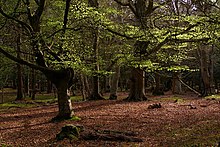New Forest
New Forest er en af de største uindhegnede områder med overdrev, hede og skov i Sydengland, der dækker det sydvestlige Hampshire og sydøstlige Wiltshire. Det blev erklæret som kongelig skov af Vilhelm Erobreren, og den nævnes i Domesday Book fra 1086.
Skovområdet er hjem for New Forest Commoners, hvis gamle rettigheder til græsningsarealer stadig anerkendes og udøves, og håndhæves af verderers og agisters. I 1700-talle blev New Forest en kilde til tømmer til Royal Navy. Det er habitat for mange sjældne fugle og pattedyr.
Skovens grænser har variere over tid, og formålet med afgrænsningen.[1] Den dækker 28.924,5 hektar biologisk og geologisk Site of Special Scientific Interest.[2][3] Der er adskillige områder inden for New Forest, der er Geological Conservation Review sites, inklusive Mark Ash Wood,[4] Shepherd’s Gutter,[5] Cranes Moor,[6] Studley Wood,[7] og Wood Green.[8] Der er også flere Nature Conservation Review sites.[9] Det er et Special Area of Conservation,[10] et Ramsar site[11][12] og et Special Protection Area.[13][14] Copythorne Common drives af Hampshire and Isle of Wight Wildlife Trust,[15] Kingston Great Common er et national nature reserve[16] og New Forest Northern Commons drives National Trust.[17]
New Forest dækker to valgkredse; New Forest East og New Forest West.
Referencer
- ^ Se eksempelivs National Park boundary: Skabelon:Hansard
- ^ "Designated Sites View: The New Forest". Sites of Special Scientific Interest. Natural England. Hentet 15. maj 2020.
- ^ "Map of The New Forest". Sites of Special Scientific Interest. Natural England. Hentet 15. maj 2020.
- ^ "Mark Ash Wood (Quaternary of South Central England)". Geological Conservation Review. Joint Nature Conservation Committee. Hentet 21. april 2020. (Webside ikke længere tilgængelig)
- ^ "Shepherd's Gutter, near Bramshaw (Palaeogene)". Geological Conservation Review. Joint Nature Conservation Committee. Hentet 21. april 2020. (Webside ikke længere tilgængelig)
- ^ "Cranes Moor (Quaternary of South Central England)". Geological Conservation Review. Joint Nature Conservation Committee. Hentet 21. april 2020. (Webside ikke længere tilgængelig)
- ^ "Studley Wood (Palaeogene)". Geological Conservation Review. Joint Nature Conservation Committee. Hentet 21. april 2020. (Webside ikke længere tilgængelig)
- ^ "Wood Green Gravel Pit (Quaternary of South Central England)". Geological Conservation Review. Joint Nature Conservation Committee. Hentet 21. april 2020. (Webside ikke længere tilgængelig)
- ^ Ratcliffe, Derek, red. (1977). A Nature Conservation Review. Vol. 2. Cambridge, UK: Cambridge University Press. s. 51-52, 120-21, 206-07. ISBN 0521-21403-3.
- ^ "Designated Sites View: New Forest". Special Areas of Conservation. Natural England. Hentet 24. april 2020.
- ^ "Designated Sites View: Solent and Southampton Water". Ramsar Site. Natural England. Hentet 23. april 2020.
- ^ "Designated Sites View: The New Forest". Ramsar Site. Natural England. Hentet 23. april 2020.
- ^ "Designated Sites View: Solent and Southampton Water". Special Protection Areas. Natural England. Hentet 23. april 2020.
- ^ "Designated Sites View: The New Forest". Special Protection Areas. Natural England. Hentet 23. april 2020.
- ^ "Copythorne Common". Hampshire and Isle of Wight Wildlife Trust. Hentet 29. april 2020.
- ^ "Designated Sites View: Kingston Great Common". National Nature Reserves. Natural England. Hentet 24. april 2020.
- ^ "New Forest Northern Commons". National Trust. Hentet 24. april 2020.
Eksterne henvisninger
Medier brugt på denne side
(c) Jim Champion, CC BY-SA 2.0
Beech trees in Mallard Wood, New Forest. Mallard Wood lies to the south of the A35 road, mid-way between Lyndhurst and Ashurst. The open woodland is grazed by commoners' stock and wild deer, hence the lack of lower branches and ground cover. Here the late afternoon sun is illuminating new leaves on these beech trees.


